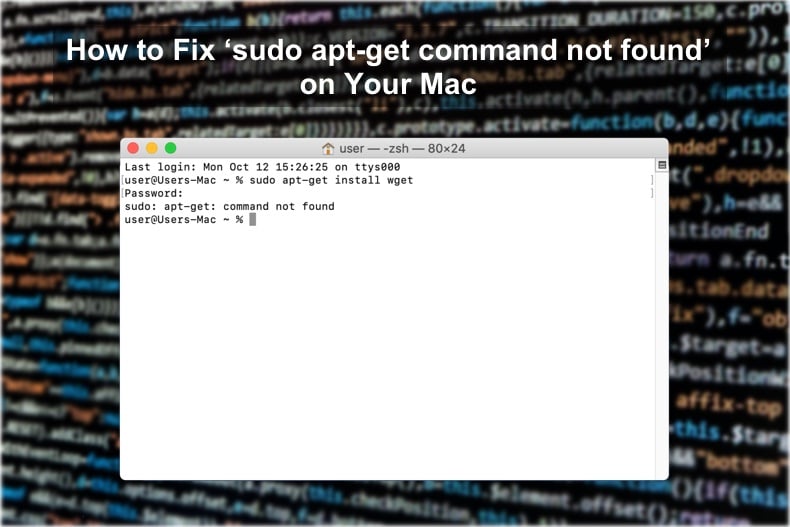Sudo Command Not Found Mac Catalina
- Sudo Command Not Found Mac Catalina Download
- Sudo Command Not Found Mac Catalina Version
- Sudo Command Not Found Mac Catalina Free
- Sudo Command Not Found Mac Catalina Update
Troubleshooting
Sudo killall VDCAssistant;sudo killall AppleCameraAssistant. Type your admin password to authenticate, and then try to use your webcam again. Download memu for mac. MacOS should relaunch any processes your webcam relies on to function. If you don’t feel comfortable using Terminal, just restart your Mac instead of running the above command. Restart Your Mac. To test the configuration, press Command+Ctrl+Q to lock the Mac. Make sure your YubiKey is not plugged in to the Mac and attempt to login; you should not be able to login, even with the correct password. Then, insert the YubiKey and confirm you are able to login after entering the correct password. Enabling the Configuration.

Sudo Command Not Found Mac Catalina Download
Problem
Sudo Command Not Found Mac Catalina Version
Cause
Resolving The Problem

- If you have the IM installer files in a macOS folder like Downloads or Documents, move them to a folder that you created manually in a non-special location, like the root of your home directory (for example: ~/installers).
- Open the Terminal application.
- cd to the RPT_SETUP directory.
- Run the command: sudo xattr -rcs .
This command removes the extended attributes for all the files under the current directory. Some of these attributes are preventing the installation. Since these attributes are not required for the installation, it is safe to remove all of them. - Enter your sudo password.
This screen capture shows the previous steps: - Verify that all metadata was stripped by using this command:
sudo xattr -lr .
This command returns no output if the metadata was successfully stripped. If there is output, that means all metadata was not stripped. Do not proceed to the next step until all metadata is stripped. - Go back to Finder and run Install.app.
- IM now starts and you can proceed with the installation.
Document Location
Document Information
Mac os mavericks dmg. Modified date:
19 March 2021
These advanced steps are primarily for system administrators and others who are familiar with the command line. You don't need a bootable installer to upgrade macOS or reinstall macOS, but it can be useful when you want to install on multiple computers without downloading the installer each time.
What you need to create a bootable installer
- A USB flash drive or other secondary volume formatted as Mac OS Extended, with at least 14GB of available storage
- A downloaded installer for macOS Big Sur, Catalina, Mojave, High Sierra, or El Capitan
Download macOS
- Download: macOS Big Sur, macOS Catalina, macOS Mojave, or macOS High Sierra
These download to your Applications folder as an app named Install macOS [version name]. If the installer opens after downloading, quit it without continuing installation. To get the correct installer, download from a Mac that is using macOS Sierra 10.12.5 or later, or El Capitan 10.11.6. Enterprise administrators, please download from Apple, not a locally hosted software-update server. - Download: OS X El Capitan
This downloads as a disk image named InstallMacOSX.dmg. On a Mac that is compatible with El Capitan, open the disk image and run the installer within, named InstallMacOSX.pkg. It installs an app named Install OS X El Capitan into your Applications folder. You will create the bootable installer from this app, not from the disk image or .pkg installer.
Use the 'createinstallmedia' command in Terminal
- Connect the USB flash drive or other volume that you're using for the bootable installer.
- Open Terminal, which is in the Utilities folder of your Applications folder.
- Type or paste one of the following commands in Terminal. These assume that the installer is in your Applications folder, and MyVolume is the name of the USB flash drive or other volume you're using. If it has a different name, replace
MyVolumein these commands with the name of your volume.
Big Sur:*
Catalina:*
Mojave:*
High Sierra:*

El Capitan:
* If your Mac is using macOS Sierra or earlier, include the --applicationpath argument and installer path, similar to the way this is done in the command for El Capitan.
After typing the command:
- Press Return to enter the command.
- When prompted, type your administrator password and press Return again. Terminal doesn't show any characters as you type your password.
- When prompted, type
Yto confirm that you want to erase the volume, then press Return. Terminal shows the progress as the volume is erased. - After the volume is erased, you may see an alert that Terminal would like to access files on a removable volume. Click OK to allow the copy to proceed.
- When Terminal says that it's done, the volume will have the same name as the installer you downloaded, such as Install macOS Big Sur. You can now quit Terminal and eject the volume.
Use the bootable installer


Determine whether you're using a Mac with Apple silicon, then follow the appropriate steps:
Apple silicon
- Plug the bootable installer into a Mac that is connected to the internet and compatible with the version of macOS you're installing.
- Turn on your Mac and continue to hold the power button until you see the startup options window, which shows your bootable volumes.
- Select the volume containing the bootable installer, then click Continue.
- When the macOS installer opens, follow the onscreen instructions.
Intel processor
- Plug the bootable installer into a Mac that is connected to the internet and compatible with the version of macOS you're installing.
- Press and hold the Option (Alt) ⌥ key immediately after turning on or restarting your Mac.
- Release the Option key when you see a dark screen showing your bootable volumes.
- Select the volume containing the bootable installer. Then click the up arrow or press Return.
If you can't start up from the bootable installer, make sure that the External Boot setting in Startup Security Utility is set to allow booting from external media. - Choose your language, if prompted.
- Select Install macOS (or Install OS X) from the Utilities window, then click Continue and follow the onscreen instructions.
Learn more
Sudo Command Not Found Mac Catalina Free
A bootable installer doesn't download macOS from the internet, but it does require an internet connection to get firmware and other information specific to the Mac model.
Sudo Command Not Found Mac Catalina Update
For information about the createinstallmedia command and the arguments you can use with it, make sure that the macOS installer is in your Applications folder, then enter the appropriate path in Terminal: